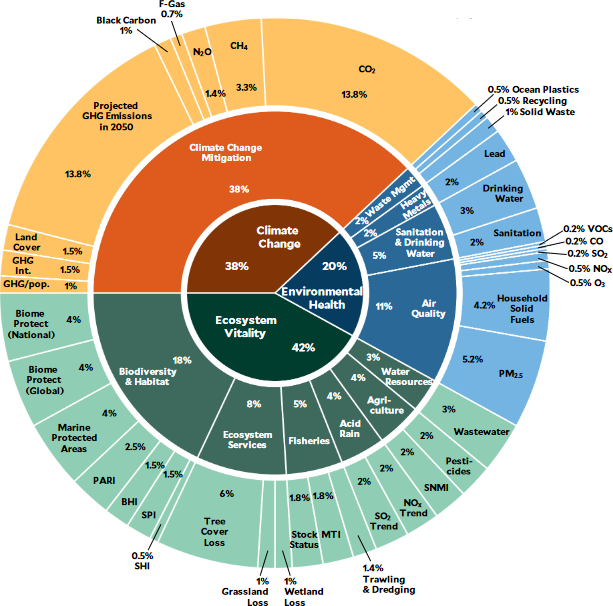Sustainability¶
Waste is a design flaw.
—Kate Kreba
Sustainable development goals¶
In 1987, the United Nations Brundtland Commission defined sustainability as “meeting the needs of the present without compromising the ability of future generations to meet their own needs.”
Sustainable development requires an integrated approach that takes into consideration environmental concerns along with economic development.
In 2015, the United Nations established adopted 17 Sustainable Development Goals (SDGs):

Exercise: United Nations Sustainable Development Goals
Discuss which of the 17 UN SDGs might be most impacted by the actions of chemical and biological engineers.
Factors affecting sustainability¶
Global inequality¶
Because equity is an essential component of sustainability, it is important to examine this issue from multiple perspectives.
Exercise: Interpreting global inequality
Carefully examine each figure below and consider what it is telling you about global inequality.
Would you have predicted these trends and rankings?
Why would these results be important when considering sustainability?
In each of the figures below, you can view the changes over time by clicking on the play button. Also, you can alter various aspects of the figures using the icons to the right of each figure. Click on the ‘COLOR’ icon to see the meaning of the colors or adjust their meaning.
How do we measure sustainability?¶
There are numerous indices and systems that attempt to capture a country’s sustainability and provide a means to compare countries and provide a quantitative value that can be used for a country to track and improve its sustainability practices. These indices include the Environmental Performance Index (EPI), Human Development Index (HDI), Happy Planet Index (HPI), Sustainable Development Goals Index (SDGI), and Sustainable Development Index (SDI).
Note
It is important to recognize that there is often little agreement among the rankings generated by these various systems. In fact, a country may rank near the top in one system, but among the bottom in another. Thus, it is best to understand the details of the index (purpose, data, analysis procedures, weighting factors, etc.) and how it might or might not address the specific questions you are trying to answer.
Because it is an often cited system, we’ll look at some of the latest results for the Environmental Performance Index.
The Environmental Performance Index¶
The Environmental Performance Index (EPI) provides a data-driven summary of the state of sustainability around the world. Using 40 performance indicators across 11 issue categories, the EPI ranks 180 countries on climate change performance, environmental health, and ecosystem vitality. These indicators provide a gauge at a national scale of how close countries are to established environmental policy targets. Details about the methodology are given in the Environmental Performance Index report and technical details about the data and calculations are provided in the technical appendix .
Here is a figure representing the EPI framework. There are 40 performance indicators that fall into 11 issue categories, which are aggregated into three policy objectives. Weights show the percentage of the total EPI score.

Below is part of a table of the 2022 results arising from the framework. Click on the table to access a live version and more information.

As you can see, Denmark is the leader with a score of 77.90, the United States is ranked 43rd with a score of 51.10, and India was the poorest performer of all countries evaluated with a score of 18.90.
The full EPI results can be queried and visualized in various ways using the DATAVIS Dashboard .
Principles of Green Engineering¶
At the conference Green Engineering: Defining the Principles, a committee of
engineers and scientists developed Nine Principles of Green Engineering:
Engineer processes and products holistically, use systems analysis, and integrate environmental impact assessment tools.
Conserve and improve natural ecosystems while protecting human health and well-being.
Use life-cycle thinking in all engineering activities.
Ensure that all material and energy inputs and outputs are as inherently safe and benign as possible.
Minimize depletion of natural resources.
Strive to prevent waste.
Develop and apply engineering solutions, while being cognizant of local geography, aspirations, and cultures.
Create engineering solutions beyond current or dominant technologies; improve, innovate, and invent (technologies) to achieve sustainability.
Actively engage communities and stakeholders in development of engineering solutions
The role of chemical and biological engineers in sustainability¶
Consistent with the above principles are a number of specific activities in which CBEs are involved, including developing and implementing…
Alternative energy sources
Alternative feedstocks (biobased) for energy (bioenergy) and chemicals (biorefinery and biomass to liquids)
Alternative raw materials
Green Processes with minimal footprint and minimal environmental impact
Process intensification that minimizes energy/exergy losses (see the Note below)
Recycling
Processes for assuring the quality of water, food, and medicines
Note
Process intensification can be defined as the development of innovative apparatuses and technologies that bring dramatic improvements in chemical manufacturing and processing, substantially reducing equipment volume, energy consumption, or waste formulation, and ultimately leading to cheaper, safer, sustainable technologies.
There are four guiding principles: (i) maximize the effectiveness of intramolecular and intermolecular events; (ii) provide all molecules the same process experience; (iii) optimize driving forces at all scales and maximize the specific surface areas to which they apply; and (iv) maximize synergistic effects from partial processes.
Exercise: Misconceptions about sustainability
The Gapminder organization identifies systematic misconceptions about important global trends and proportions and uses reliable data to develop easy to understand teaching materials to rid people of their misconceptions.
In 2020, they created a study with 18 questions related to the UN Sustainable Development Goals (SDGs).
They found that Monkeys do better than people in Sweden, Denmark, Norway, and Finland on sustainability facts!
See how you do on the Sustainable Development Misconception Study.